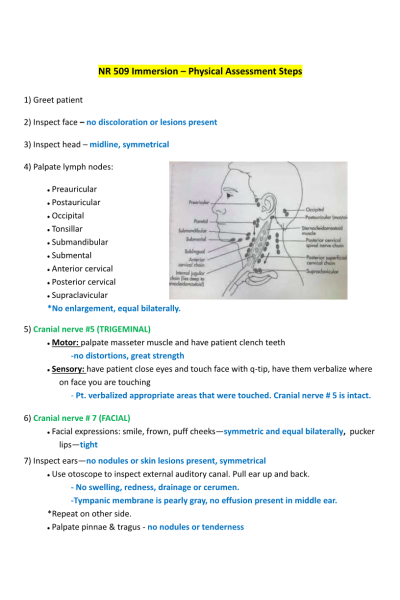NR 509 Week 7 Immersion; Physical Assessment Study Guide
| Institution |
Chamberlain |
| Contributor |
Lydia |
- Greet patient
- Inspect face – no discoloration or lesions present
- Inspect head – midline, symmetrical
- Palpate lymph nodes:
- Cranial nerve #5 (TRIGEMINAL)
- Cranial nerve # 7 (FACIAL)
- Inspect ears—no nodules or skin lesions present, symmetrical
- Cranial nerve # 8 (ACOUSTIC)
- Inspect eyes—conjunctiva clear and pink, no drainage or lesions present; sclera white and clear.
- Cranial nerve #2 (OPTIC)
- Cranial nerves #3 (OCULOMOTOR), #4 (TROCHLEAR), & #6 (ABDUCENS)
- Inspect nose—midline, no obstructions, swelling or visible fractures
- Palpate frontal and maxillary sinuses—assess for tenderness
- Inspect throat and mouth:
- Cranial nerve #9 (GLOSSOPHARYNGEAL)
- Cranial nerve #10 (VAGUS)
- Cranial nerve #12 (HYPOGLOSSAL)
- Palpate TMJ (temporomandibular joint)
- Inspect neck—symmetrical, no obvious deformities
- Palpate carotid arteries (side of trachea) — normal and bounding
- Range of motion—NECK
- Cranial nerve #11 (SPINAL ACCESSORY)
- Heart sounds—5 areas:
- Inspect anterior chest—assess for any obvious deformities and symmetry—none found
- Auscultate lung sounds— have patient breathe in and out through mouth
- Inspect upper extremities
- Assess ROM (*Normally assess bilaterally but for immersion only assess unilaterally)
- Cerebellar coordination
- Deep tendon reflexes (only evaluate unilaterally for immersion)
- Abdominal exam
- Percuss all 4 quadrants: checking for tympany, dullness, or flatness—normal
- Palpate all 4 quadrants (had over hand, circular motion)
- Palpate liver:
- Palpate spleen:
- Test Bloomberg sign:
- Inspect lower extremities—no edema or lesions noted
- Range of motion—HIP
- Range of motion—KNEE
- Range of motion—ANKLE
- Palpate dorsalis pedis pulses—2+ and equal bilaterally
- Spine exam (have patient stand up)
- Romberg’s test:
- Gait:
| Instituition / Term |
| Term |
Summer 2020 |
| Institution |
Chamberlain |
| Contributor |
Lydia |

















